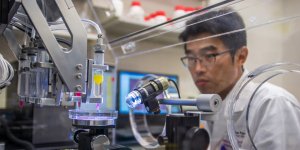Science News

Protein patterns that look like flowers, trees, snowflakes could have applications in human health. »

NASA’s newest planet hunter, the Transiting Exoplanet Survey Satellite (TESS), has discovered three new worlds — one slightly larger than Earth and two of a type not found in our solar system — orbiting a nearby star. »

Scientists paint a picture of how solar cycles suddenly die, potentially causing tsunamis of plasma to race through the sun's interior and trigger the birth of the next sunspot cycle only a few weeks later. »

Scientist have identified a link between exposure to high levels of oestrogen sex hormones in the womb and the likelihood of developing autism. »

Rock core samples from a period of warming millions of years ago indicate that soils contributed to a rapid rise in atmospheric greenhouse gases and suggest that modern climate models may overestimate Earth's ability to mitigate future warming, according to an international team of scientists. »

Vast rings of electrically charged particles encircle the Earth and other planets. Now, a team of scientists has conducted research into waves that travel through this magnetic, electrically charged environment, known as the magnetosphere, deepening understanding of the region. »

Scientists have confirmed that viruses can kill marine algae called diatoms, but diatom die-offs near the ocean surface may provide nutrients and organic matter for recycling by other algae. »

In the 1960s, University of Pennsylvania biologist Dan Janzen re-described what has become a classic example of biological mutualism: the relationship between acacia-ants and ant-acacia trees. The acacia trees produce specialized structures to shelter and feed the ant colony, and the ants, in turn, defend the tree against herbivores. »

Scientists say they have almost eradicated populations of the world’s most invasive mosquito species from two test sites in China using a novel two-pronged approach which renders the insects infertile. »

Hyperglycemia, or high levels of glucose, is common in patients with acute ischemic stroke and is associated with worse outcomes compared to normal blood sugar levels. Stroke experts have debated whether intensive glucose management after acute ischemic stroke leads to better outcomes but a new study in JAMA finds that aggressive methods are not better than standard approaches. »

In work that could open future applications for a new class of nanomaterials known as MXenes, researchers at Texas A&M University have discovered a simple, inexpensive way to prevent the materials’ rapid degradation. »

Study of lovebirds’ flight could lead to better visual control algorithms for autonomous aerial robots. »

The molten rock that feeds volcanoes can be stored in the Earth’s crust for as long as a thousand years, a result which may help with volcanic hazard management and better forecasting of when eruptions might occur. »

Scientists reveal first reconstructions of extinct species and computer map of Saharan Seaway. »

Scientists reveal protein responsible for a bitter taste. Will it help us eat our greens? »

The El Niño climate cycle has been responsible for widespread simultaneous crop failure in different regions of the world, a study has found, putting pressure on countries to prepare for future weather events. »

Scientists at the University of Cambridge have uncovered striking similarities in how two distantly related plants defend themselves against pathogens despite splitting from their common ancestor more than 400 million years ago. »

Elevated blood pressure in the first trimester of pregnancy, or an increase in blood pressure between the first and second trimesters, raises the chances of a high blood pressure disorder of pregnancy. »

A study indicated that a chemical used in some toothpastes, soaps and antibacterial products puts women at a higher risk of developing osteoporosis. »

Rising temperatures in the tundra of northern latitudes could affect microbial communities in ways likely to increase their production of the greenhouse gases methane and carbon dioxide, a new study of experimentally warmed Alaskan soil suggests. »

Moderately reducing caloric intake over a period of two years significantly improved cardiometabolic risk factors in young and middle-aged, non-obese adults, according to new findings from the Comprehensive Assessment of Long-term Effects of Reducing Intake of Energy. »

Coral reefs are retreating from equatorial waters and establishing new reefs in more temperate regions. »

Patients who have been diagnosed with diabetes are at a lower risk of early death if they have a doctor who they describe as showing empathy towards them, a new study from the University of Cambridge has found. »

Research by scientists at Brown and Columbia Universities has demonstrated the existence of previously unknown states of matter that arise in double-layer stacks of graphene, a two-dimensional nanomaterial. »

Scientists at the University of South Florida in St. Petersburg's College of Marine Science used NASA satellite observations to discover and document the largest bloom of macroalgae in the world, dubbed the Great Atlantic Sargassum Belt. »

Anyone who has ever sensed that a person is sick simply by looking at their face has experienced the wealth of information conveyed by face color. A new study provides evidence that the human brain’s visual system is especially sensitive to the color of faces compared to the colors of other objects or things. »

A team of Indian scientists has developed a compound from the leaf of the mango (Mangifera indica) tree that can protect ships from rusting and which is far more efficient than synthetic paints while also being non-toxic and environment-friendly. »

Space, Engineering.
Juno would be the first solar-powered spacecraft to operate so far from the Sun. »

Scientists from the University of Granada and Liverpool John Moores University (UK) have established that school children who use backpacks should avoid loads of more than 10% of their body weight—and those who use trolleys, 20% of their body weight. »

Brazilian researchers have developed a low-cost method of classifying the most common malignant brain tumour in children, which they say can help medics diagnose and treat the condition. »

A new study had review worldwide scientific literature on the role of dairy products in health and in the prevention of chronic diseases. The review also covers the effects of dairy products on growth, bone mineral density, generation of muscle mass, and during pregnancy or breastfeeding. »

Two caves -- the Grotta del Fossellone and Grotta di Sant'Agostino -- near the beaches of what is now Italy's west coast are producing some of the earliest evidence of ancient humans using adhesive on their stone tools, an important technological advance called "hafting." »

Scientists have identified mechanisms in the human brain that could help explain the phenomenon of the ‘Uncanny Valley’ – the unsettling feeling we get from robots and virtual agents that are too human-like. »

Space, Science, Technology.
An orbiting carbon observatory on the International Space Station will measure both atmospheric carbon and plant activity. »

Soils unearthed by deforestation and agriculture unleashing CO2 »

Cyanide and carbon monoxide are both deadly poisons to humans, but compounds containing iron, cyanide, and carbon monoxide discovered in carbon-rich meteorites by a team of scientists at Boise State University and NASA may have helped power life on early Earth. »

New research shows that an iceless Greenland may be in the future. If worldwide greenhouse gas emissions remain on their current trajectory, Greenland may be ice-free by the year 3000. By the end of the century, the island could lose 4.5% of its ice, contributing up to 13 inches of sea level rise. »

Feet from the raw bars and seashell-colored condominiums of Florida's Cedar Key, NSF-supported researchers at the Florida Museum of Natural History and California State University discovered a new species of sea slug that is a rare outlier in a group famous for being ultra-vegetarians. »

Plants need nutrients to grow. So scientists were surprised to learn that giant kelp maintains its impressive growth rates year-round, even in summer and early fall when ocean currents along the California coast stop delivering nutrients. »

Vast subtropical gyres -- large systems of rotating currents in the middle of the oceans -- cover 40% of the Earth. The gyres have long been considered biological deserts, with waters that contain very few nutrients to sustain life. »

Higher levels of a customary gut bacteria enhanced by breastfeeding in early infancy were found to be coupled with an improved response to vaccines in infants through two years of age. »

A new research suggests that time of day exercise is completed may impact its physical effects. »

Science, Oceans, Earth.
The glacier has been one of the island's largest contributor's to sea level rise, but in a new study, it grew slightly and the rate of mass loss slowed down. »

Since scientists first determined that atmospheric carbon dioxide was lower during ice ages than during warm phases, they have looked at why, theorizing that it may be a function of ocean circulation, sea ice, iron-laden dust or temperature. »

Winter ice on the surface of Antarctica's Weddell Sea sometimes has an enormous hole called a polynya. A polynya that appeared in 2016 and 2017 offered a unique opportunity for oceanographers to monitor this expanse of ice-free water. »

Space, Universe.
In this video, discover how NASA has explored the space beyond Earth and our solar system. »

Device measures hormones in sweat, blood, urine or saliva to determine stress. »





